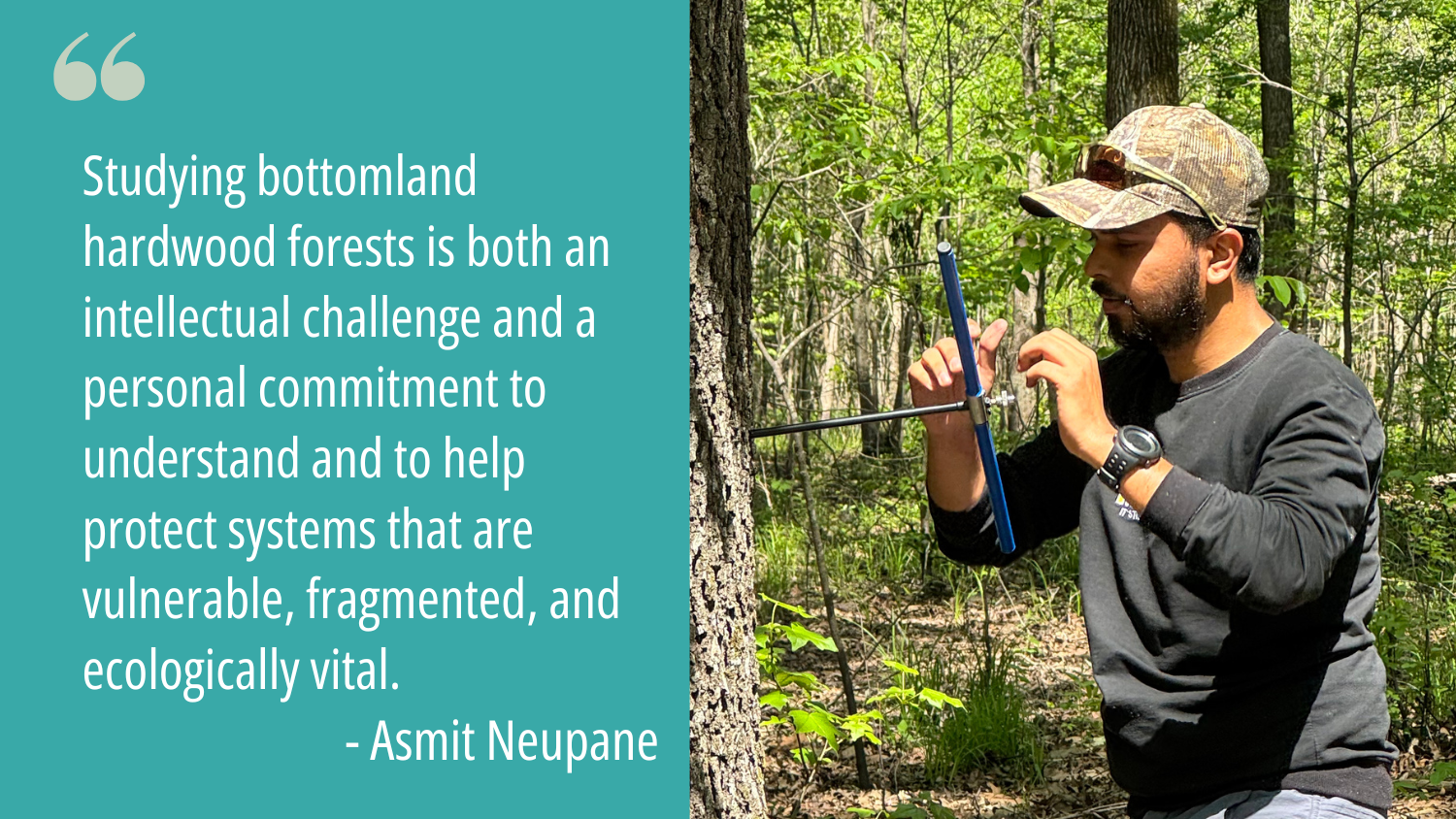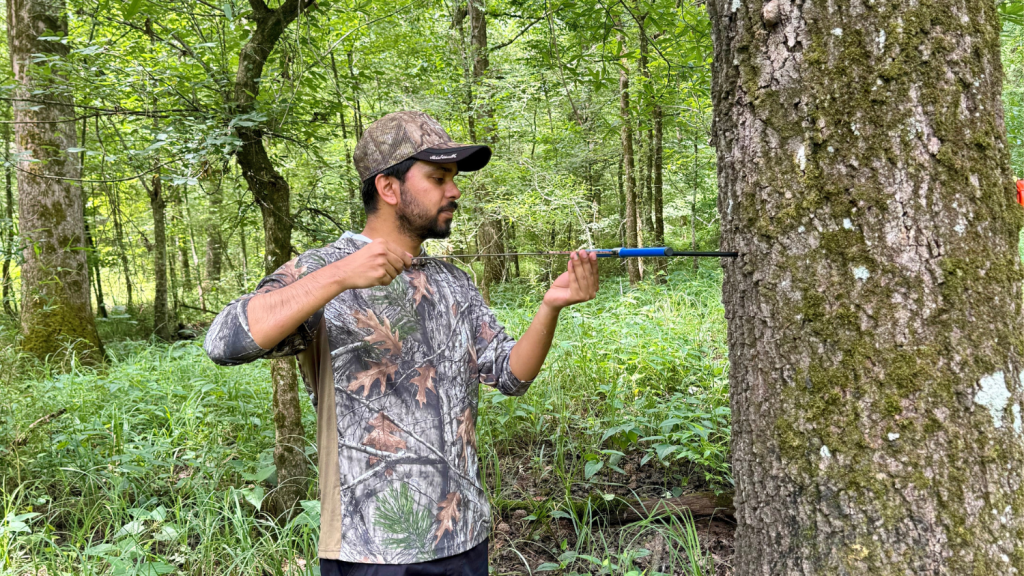Researcher Spotlight – Asmit Neupane

2025-26 Global Change Research Fellow
MSc Student, College of Forestry, Agriculture, and Natural Resources, University of Arkansas at Monticello
Advisor: Dr. Marco Yanez
About You
What do you study?
I study how forests respond to a changing climate, and what those responses mean for the ecosystems and people who depend on them. My research focuses on bottomland hardwood forests in the Lower Mississippi Alluvial Valley, one of the most biologically rich but also most altered ecosystems in North America. These forests were heavily converted to agriculture after European settlement, leaving only fragments of what once existed. Today, they face new challenges from rising temperatures and increasingly unpredictable rainfall patterns, which bring both intense droughts and frequent floods. I am particularly interested in how red oaks, trees that are foundational to these systems, are coping with these extremes, and how that knowledge can inform conservation and management in the decades ahead.
What influenced you to go into this field of study?
Growing up in Nepal, I developed an early awareness of the central role forests play in human life. Communities relied on them for food, fodder, and fuelwood, but they were also cultural spaces, places for gathering and meaning. As I studied forestry and worked with local communities on conservation projects, I saw how climate change was reshaping these relationships. That reality became even more personal during my time in the Everest region of the Himalayas, where I witnessed firsthand the negative impacts of climate change on livelihoods, including the Thame glacial lake outburst flood in early 2024. That realization led me to ask broader questions: What will happen to these forests in the future? How do forests adapt to stress? Which species persist, and which decline? And how can science help guide management in ways that sustain both ecosystems and people? These questions eventually carried me across the globe to the bottomland hardwood forests of the southern United States. For me, studying these forests is both an intellectual challenge and a personal commitment to understand and to help protect systems that are vulnerable, fragmented, and ecologically vital.
What do you think is the most pressing issue related to global change?
The southern United States is experiencing some of the most visible impacts of climate change, including rising temperatures, altered rainfall patterns, and an increasing frequency of extreme events such as droughts, floods, and hurricanes. These extremes often have greater consequences than gradual changes, as they can rapidly push ecosystems and species beyond their thresholds of resilience. I believe the most pressing issue is how ecosystems respond to climate extremes that push species to their limits. Average temperature rise and shifting rainfall matter, but it is the extremes that often determine survival or failure for ecosystems. This connects closely to my research, since bottomland hardwood forests are already stressed by fragmentation and land-use change. Understanding how trees in these systems withstand or fail to withstand these extremes is essential if we want to conserve them, restore them, and manage them effectively under a future that will be more variable and less predictable than the past.
About Your Research

What results are you finding?
So far, I’ve learned that bottomland hardwood forests are both incredibly complex and surprisingly sensitive. Even a change of just a foot in elevation can shift which species grow there and how they respond to stress. The two red oaks I am studying are: Willow oak (Quercus phellos), which thrives in the wetter, low-lying areas, can handle floods but struggles during drought, and Cherrybark oak (Quercus pagoda), growing in slightly higher elevation and can tolerate drought better but is much less resilient to flooding. By combining tree-ring data with stable carbon isotope analysis, I’ve been able to trace how these species responded to the driest and wettest years since 1990. What this reveals is not only their growth patterns, but also their underlying physiological strategies for coping with stress. These fine-scale differences have big implications for adaptive forest management, because they highlight just how much micro-variability matters in determining the future of these ecosystems under climate change.
Who will benefit from your research?
This research is designed to be useful to landowners, forest managers, Green Tree Reservoirs, and conservation practitioners in the Lower Mississippi Alluvial Valley. Current drought vulnerability maps for the region rely on coarse-resolution MODIS satellite data, which cannot capture the fine-scale fragmentation of bottomland hardwoods. Many forest patches are smaller than a single MODIS pixel. By using higher-resolution Landsat imagery and linking it with field-based tree data, I am developing more precise vulnerability maps. Together with species-specific response data, these tools will help guide decisions on where and how to reforest, and which species may be best suited to withstand future climate extremes.
How would you describe your research to a 3rd grader?
Imagine two kinds of oak trees. One likes to keep its feet wet, growing near swampy spots, and the other likes to stay a little higher up where it’s drier. I study how these trees handle “bad weather years”, like when it rains too much or doesn’t rain at all. Trees keep a diary of their lives in their rings, which are the circles that you see in a stump, and by reading those rings, I can see how they did in good years and bad years. I also make maps that show which forests might get thirsty first when a big drought comes, so people know how to take care of them.
About Your Global Change Research Fellow Experience
How do you expect the SE CASC Global Change Research Fellows Program to impact you and your work?
This fellowship is equipping me with both conceptual frameworks and practical tools to situate my research within the broader field of global change science. Beyond the disciplinary training I receive in forestry, SE CASC provides exposure to diverse perspectives on climate impacts, ranging from coastal resilience and wildlife conservation to Indigenous knowledge systems and human dimensions of climate adaptation. Engaging with this interdisciplinary cohort challenges me to think critically about how methods such as dendrochronology and stable isotope analysis can inform not just ecological theory, but also applied management decisions. I also see the program as a valuable platform to strengthen my skills in science communication, stakeholder engagement, and translational research skills that are essential for ensuring that findings about forest vulnerability and resilience are accessible to land managers, policymakers, and local communities.
What advice would you give to a student that is interested in getting involved in your field?
Start by building curiosity about how ecosystems function and how they respond to changes. Don’t worry if you lack all the technical skills at first; those can be learned. What matters is asking questions that connect science to real-world problems. Also, don’t be afraid to step outside your comfort zone. My journey took me from working in Nepal’s community forests to studying American bottomland hardwoods, very different systems, but connected by the same global challenge of climate change. And just as important, seek out mentors and communities. The path can feel overwhelming, but having people to guide you and colleagues to learn with makes the journey meaningful and rewarding.
What has been the most rewarding part or your favorite part of being a SE CASC Global Change Research Fellow?
The most rewarding aspect has been the opportunity to engage in a truly interdisciplinary cohort. The expertise from the SE CASC team and my fellow scholars work on systems ranging from coastal marshes and fisheries to climate justice and Indigenous knowledge, and those diverse perspectives have sharpened the way I think about my own research on bottomland hardwood forests. The workshops and seminars have been especially valuable for exploring methodological approaches outside my core training, like integrating social science perspectives on adaptation planning or learning about decision‐support tools used by climate experts. These exchanges have helped me place my work on tree‐ring analysis and climate extremes in a broader context of applied global change research. Most importantly, the program has reinforced that while each of us investigates a specific system or question, the collective insights across disciplines are essential for informing regional and national climate adaptation strategies.
Is there anything else you would like to share?
Paraphrasing Henry David Thoreau: “I took a walk in the woods and came out taller than the trees.” This line captures the quiet wisdom and perspective that nature offers. Forests teach us humility, patience, and stewardship, showing both fragility and resilience. In the face of climate change, these lessons become even more urgent: protecting and managing landscapes thoughtfully can help ecosystems adapt to extremes and recover from disturbances. In caring for forests, we are not just safeguarding nature, but also the people and communities that depend on it. Walking among the trees, as Thoreau describes, reminds us that observing and learning from nature can make us more aware, thoughtful, and capable of guiding forests and ourselves through a changing world.
Learn more about the Southeast Climate Adaptation Science Center’s Global Change Research Fellows program.
- Categories:
